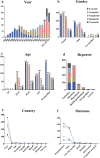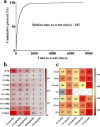Glucagon-like peptide-1 receptor agonist-induced cholecystitis and cholelithiasis: a real-world pharmacovigilance analysis using the FAERS database
- PMID: 40697657
- PMCID: PMC12279493
- DOI: 10.3389/fphar.2025.1557691
Glucagon-like peptide-1 receptor agonist-induced cholecystitis and cholelithiasis: a real-world pharmacovigilance analysis using the FAERS database
Abstract
Background: With the widespread use of glucagon-like peptide-1 receptor agonists (GLP-1 RAs) in managing diabetes and obesity, the occurrence of GLP-1 RA-induced cholecystitis and cholelithiasis has raised increasing concern among healthcare professionals.
Methods: This study extracted adverse event reports of GLP-1 RA-induced cholecystitis and cholelithiasis from the FDA Adverse Event Reporting System database, covering Q1 2004 to Q2 2024. Disproportionality analysis methods, including the reporting odds ratio, proportional reporting ratio, and Bayesian confidence propagation neural network, were employed to identify associations between GLP-1 RAs and these AEs. The analysis focused on the five most commonly prescribed GLP-1 RAs, evaluated at both high-level term and preferred term levels.
Results: A total of 1,829 reports were identified in which GLP-1 RAs were listed as the primary suspect drug, involving 1,651 patients. All three signal detection methods indicated a positive signal between GLP-1 RAs and these conditions. The majority of cases occurred in patients aged 45 years and older, with a significantly higher prevalence in females. The median onset time of GLP-1 RA-induced cholecystitis and cholelithiasis was 182 days, with variations observed across different drugs, genders, and age groups.
Conclusion: This study provides a comprehensive pharmacovigilance analysis of GLP-1 RA-induced cholecystitis and cholelithiasis, offering valuable insights into the prevention and management of these AEs.
Keywords: FAERS; cholecystitis; cholelithiasis; disproportionality analysis; glucagon-like peptide-1 receptor agonists; pharmacovigilance.
Copyright © 2025 Tao, Zhang, Wan, Zhao, Chen, Wang, Yang, Wang, Ding, Shang and Zhou.
Conflict of interest statement
The authors declare that the research was conducted in the absence of any commercial or financial relationships that could be construed as a potential conflict of interest.
Figures





Similar articles
-
PD-1/PD-L1 inhibitor-induced hyponatremia: a real-world pharmacovigilance analysis using FAERS database.Front Immunol. 2025 Jun 16;16:1561942. doi: 10.3389/fimmu.2025.1561942. eCollection 2025. Front Immunol. 2025. PMID: 40589736 Free PMC article.
-
Impact of GLP-1 receptor agonists on upper gastrointestinal endoscopy: an updated systematic review and meta-analysis.Surg Endosc. 2025 Aug;39(8):5135-5151. doi: 10.1007/s00464-025-11962-4. Epub 2025 Jul 9. Surg Endosc. 2025. PMID: 40634731
-
Fracture events associated with GLP-1 receptor agonists in FDA adverse events reporting system.Acta Diabetol. 2025 Jul;62(7):1009-1021. doi: 10.1007/s00592-024-02415-w. Epub 2024 Nov 18. Acta Diabetol. 2025. PMID: 39556224
-
Safety evaluation of irinotecan: a real-world disproportionality analysis using FAERS and JADER databases during the time period 2004-2024.Front Pharmacol. 2025 Jun 9;16:1516449. doi: 10.3389/fphar.2025.1516449. eCollection 2025. Front Pharmacol. 2025. PMID: 40552159 Free PMC article.
-
Adverse drug reactions related to methotrexate: a real-world pharmacovigilance study using the FAERS database from 2004 to 2024.Front Immunol. 2025 Jun 4;16:1586361. doi: 10.3389/fimmu.2025.1586361. eCollection 2025. Front Immunol. 2025. PMID: 40534848 Free PMC article. Review.
References
-
- Ansari H. U. H., Qazi S. U., Sajid F., Altaf Z., Ghazanfar S., Naveed N., et al. (2024). Efficacy and safety of glucagon-like peptide-1 receptor agonists on body weight and cardiometabolic parameters in individuals with obesity and without diabetes: a systematic review and meta-analysis. Endocr. Pract. 30, 160–171. 10.1016/j.eprac.2023.11.007 - DOI - PubMed
-
- Chong B., Jayabaskaran J., Kong G., Chan Y. H., Chin Y. H., Goh R., et al. (2023). Trends and predictions of malnutrition and obesity in 204 countries and territories: an analysis of the Global Burden of Disease Study 2019. eClinicalMedicine 57, 101850. 10.1016/j.eclinm.2023.101850 - DOI - PMC - PubMed
LinkOut - more resources
Full Text Sources

